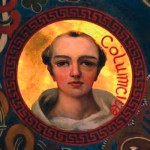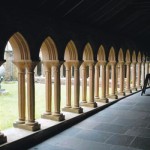The Secondary Patrons of Ireland – St. Colmcille
Colmcille, founder and first abbot of Iona off the coast of Scotland, a prince of the O’Neill clan, a great poet and scholar was born on December 7, 521 in Gartan, County Donegal. His mother, Eithne, was a princess from Leinster, and his father, Fedelmidh, was the great grandson of Niall of the Nine Hostages, an Irish king of the fifth century. Colmcille’s name is a Gaelic form of the Latin columba meaning dove. The compound colm + cille means dove of the church. Colmcille was also known as Columba of Iona, but is not to be confused with St. Columba or Columban, whose feast is November 23.
Colmcille early on determined to be a priest and a monk, but he also wished to cultivate his talents as a poet. He studied under some of Ireland's most prominent church figures. When sufficiently advanced in letters he entered the monastic school of St. Finnian of Moville. Colmcille was about twenty and a deacon. Having completed his training at Moville, he became a pupil of an aged bard named Gemman. On leaving him, Colmcille entered the monastery of St. Finnian of Clonard, who was noted for sanctity and learning. During the sixth century, some of the most significant names in the history of Irish Christianity studied at the Clonard monastery. It is said that the average number of scholars under instruction at Clonard was 3,000. Twelve students who studied under St. Finnian became known as the Twelve Apostles of Ireland; Colmcille was one of them. He was ordained a priest at Clonard. He became a student at St. Mobhi’s monastery at Glasnevin, but bubonic plague devastated Ireland in 544 causing the death of Mobhi and the dispersion of his disciples.
Colmcille returned to Ulster, the land of his kindred. He had a powerful build, with a loud, melodious voice which could be heard from one hilltop to another. There is more folklore and legend about this man than many other personalities of the early Church. In the following years, Colmcille founded several important monasteries. In 546 he was given a little hill covered with oak wood which came to be known as Doire Choluim Chille (Colmcille’s oakwood, modern Derry). This was his first monastic foundation – nothing of it survives in the modern city.
Colmcille engaged in a widespread pastoral ministry, setting up a network of monasteries over the countryside. This very active and energetic young man first ranged over Ireland and then looked about for further scope for his talents and for the advancing of the Kingdom of God. Early on, Columcille prayed to the Lord for three gifts – chastity, wisdom and pilgrimage. All three were granted to him.
Colmcille had likely already paid visits to Scotland to the Irish kingdom of Dál Riata. Adomnán, Colmcille’s first biographer, wrote that the saint determined to go to the help of the Irish community, both in the religious and political fields, since they had to face both Pictish paganism and Pictish opposition to the settlement. In 563, Colmcille travelled to Scotland with twelve companions. The island of Iona was made over to him by his kinsman Conall, king of Dál Riata, who perhaps had invited him to come to Scotland in the first place. The Irish Gaels had been colonizing the west coast of Scotland for the previous couple of centuries. Colmcille founded his new abbey as a base for spreading Christianity among the northern Pictish kingdoms who were pagan. He remained active in Irish politics, though he spent most of the remainder of his life in Scotland. The abbey became the only centre of literacy in the region, and Colmcille’s reputation as a holy man led to his role as a diplomat among the tribes.
According to a much later tradition not verified by his early biographers, Columcille embraced exile from Ireland because he lost a judgment in a copyright dispute, which eventually led to the pitched Battle of Cúl Dreimhne in 561, during which many men were killed. Supposedly Colmcille embraced exile as a penance for causing so many deaths. The whole story flies in the face of Adomnán’s testimony. It is much more likely that our saint was inspired by missionary zeal as he sailed from Ireland to the island of Iona.
Colmcille ministered to the Irish settlement at Dál Riata, and became a missionary to the pagan Picts. His wisdom became recognized in his administration of affairs. It was to Columcille that the leaders of Irish Dál Riata deferred in choosing a new king. He chose Aidan, the man ruling justly for 32 years. Whereas Adomnán just tells us that Colmcille visited Bridei (also known as Brude), the Venerable Bede relates a later, perhaps Pictish tradition, whereby the saint actually converts the Pictish king.
The story of Colmcille’s meeting Nessie -- said to have taken place in A.D. 565 -- was first recorded by Adomnán in the late 7th Century. The following is a shortened version: Once St. Colmcille had to cross the River Ness. He saw a group of people burying an unfortunate man who had been bitten by a water-monster. Colmcille ordered one of his people to swim across the river and get the boat on the other side so that he might cross. On hearing this, Lugneus plunged in to the water.
The monster charged to devour Lugneus. Colmcille traced the Sign of the Cross in the empty air. Calling upon the name of God, he commanded the savage beast, saying: “Go no further! Do not touch the man! Go back at once!” The monster retreated quickly to the depths of the Loch. Lugneus brought the boat back, unharmed and everyone was astonished.
Colmcille was a renowned man of letters, having transcribed 300 books. Hours before his death, Columcille was copying a psalter. He had reached Psalm 34, verse 10: “The young lions suffer want and hunger, but those who seek the LORD lack no good thing.” Colmcille said, “I must stop here. Let Baithene [his successor as abbot] finish it.” Colmcille died just after midnight. It was Sunday, June 9, 597.



 Entries(RSS)
Entries(RSS)